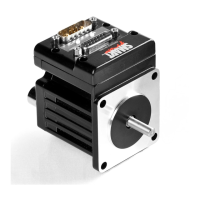Moog Animatics SmartMotor™ Developer's Guide,Rev. L
Page 384 of 909
DEL=formula
Derivative Error Limit
APPLICATION: Motion control
DESCRIPTION: Get/set the derivative error limit
EXECUTION: Immediate
CONDITIONAL TO: Servo active (MP, MV, etc., not MT mode)
LIMITATIONS: N/A
READ/REPORT: RDEL
WRITE: Read/write
LANGUAGE ACCESS: Assignment, formulas and conditional testing
UNITS: Units of position error per PID cycle *65536
RANGE OF VALUES: Input: 0 to 2147483647
TYPICAL VALUES: N/A
DEFAULT VALUE: 2147483647
FIRMWARE VERSION: 5.x and later
COMBITRONIC: DEL:3=1234
where ":3" is the motor address — use the actual address or a
variable
DETAILED DESCRIPTION:
The DELcommand is used to get (read) or set the dE/dt fault limit as follows:
l
=DEL
Gets the setting for dE/dt fault limit
l
DEL=frm
Sets the dE/dt fault limit
When the actual dE/dt reaches the value of this setting, then the dE/dt fault is tripped and the
motor will perform the fault reaction. The absolute value of the actual value is used so that
both positive and negative values of dE/dt will be compared against the DEL setting. Also, the
DELM command can modify the functionality to behave differently depending on direction of
dE/dt relative to motor direction.
DEL (Derivative Error Limit) provides the safest and quickest method to fault a motor on
sudden changes in load or detection of human interference.
The purpose of this limit is to act as a look-ahead on following error. Instead of just triggering
on a raw following error based on how far behind the motor may be in a move, the processor
is looking at how fast that following error changes.
dE/dt refers to the dynamic rate of change of following error. This results in an instant release
of energy and less chance of damage to equipment or injury to machine operator. Under
normal servo control following error limits, if the load collides against an object, the motor
will not fault until the following error limit is reached. As a result, applied current and torque
Part 2: Commands: DEL=formula

